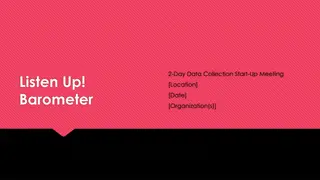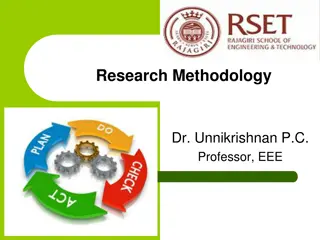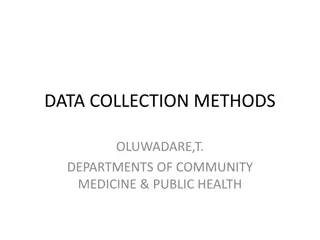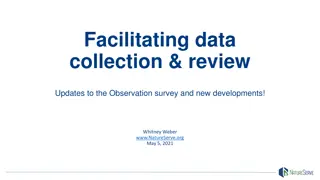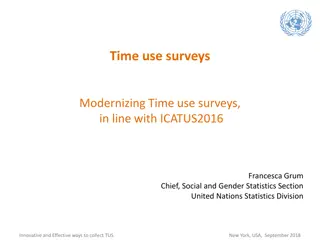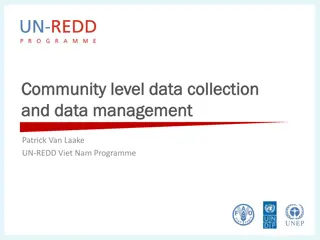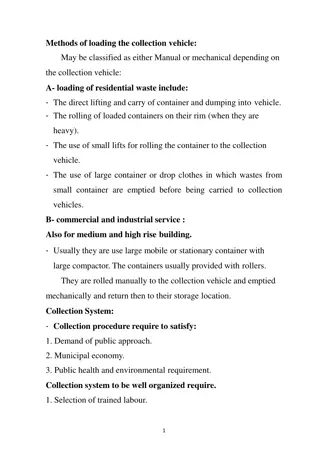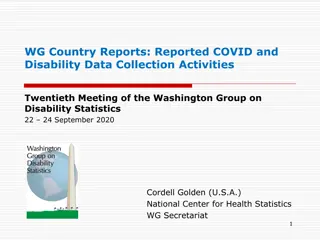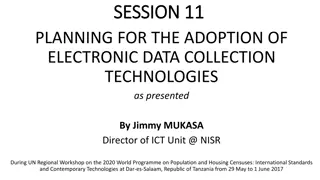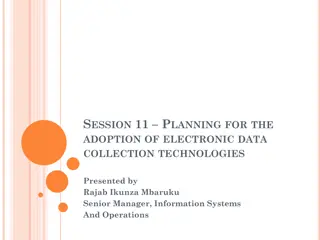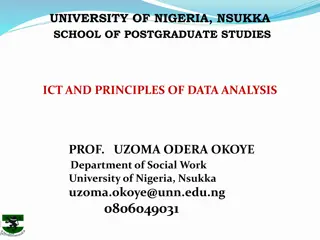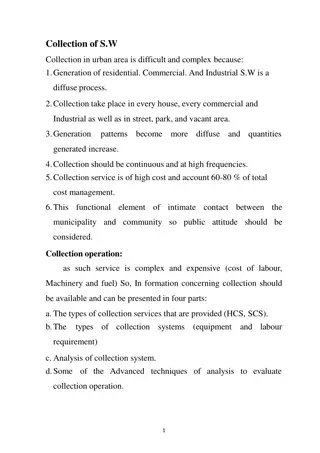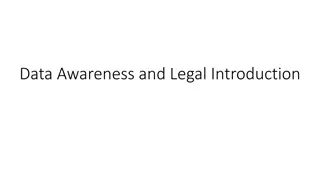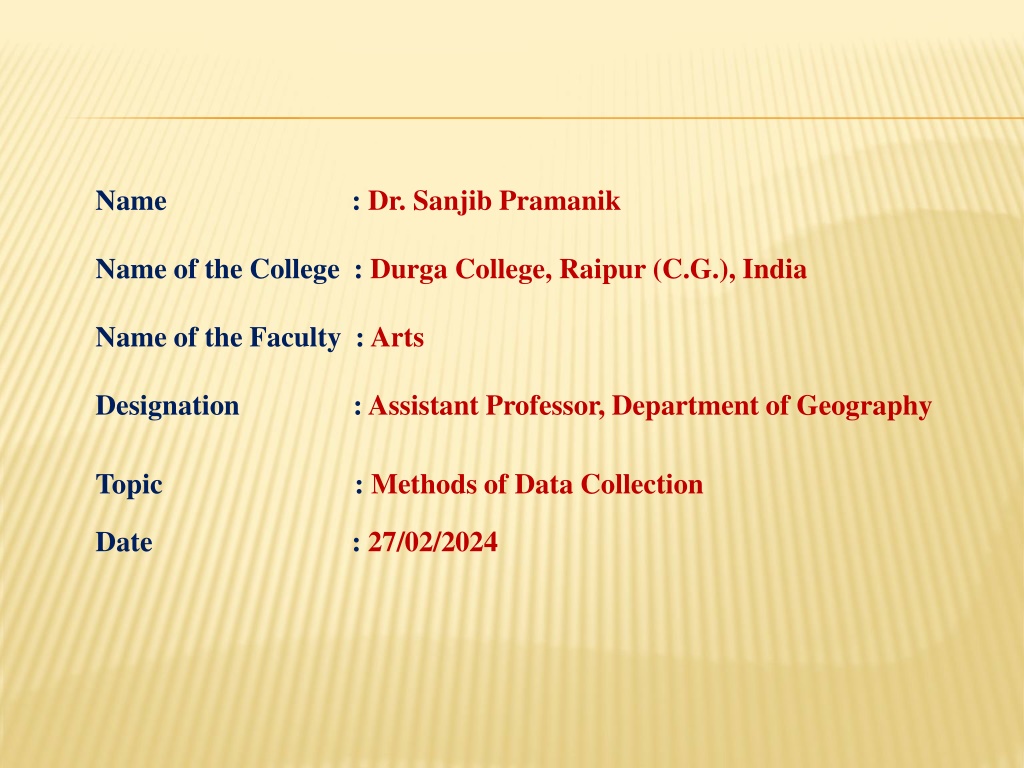
Effective Data Collection Methods in Research
Explore the importance of data collection in research, along with methods like observation and types of data such as primary and secondary. Learn about the selection criteria for data collection methods and the role of observation in obtaining accurate results.
Download Presentation

Please find below an Image/Link to download the presentation.
The content on the website is provided AS IS for your information and personal use only. It may not be sold, licensed, or shared on other websites without obtaining consent from the author. If you encounter any issues during the download, it is possible that the publisher has removed the file from their server.
You are allowed to download the files provided on this website for personal or commercial use, subject to the condition that they are used lawfully. All files are the property of their respective owners.
The content on the website is provided AS IS for your information and personal use only. It may not be sold, licensed, or shared on other websites without obtaining consent from the author.
E N D
Presentation Transcript
Name : Dr. Sanjib Pramanik Name of the College : Durga College, Raipur (C.G.), India Name of the Faculty : Arts Designation : Assistant Professor, Department of Geography Topic : Methods of Data Collection Date : 27/02/2024
INTRODUCTION The task of data collection begins after a research problem has been defined and research design/ plan chalked out. Collection of data is an essential part of research proposal. Once the purpose of statistical investigation has been defined, the problem is to collect data which are relevant to that purpose, to analyze these data and to present them in a meaningful manner.
SELECTION OF APPROPRIATE METHOD FOR DATA COLLECTION 1. Nature, scope and object of enquiry 2. Availability of funds 3. Availability of Time 4. Precision required
DATA TYPES OF DATA PRIMARY DATA SECONDARY DATA PRIMARY DATA: The primary data are those which are collected afresh and for the first time and thus happen to be original in character. SECONDARY DATA: The secondary data, on the other hand, are those which have already been collected by someone else and which have already been passed through the statistical process.
Sources of Data Primary Secondary Direct Indirect Observation Questionnaire Telephone Interview Schedule Radio & television Appeal Interview
DEFINITION OF OBSERVATION Observation is a systematic & deliberate study through the eyes of spontaneous occurrences at the time they occur. According to Lindsey Gardner in 1975 Selection provocation recording and encoding of that set of behaviors and settings concerning organisms in situ which are consistent with empirical aims . According to Sellitiz in 1970 Observation as a systematic method of data collection is quite different form merely lookingaround on lookingat something .
MEANING OF OBSERVATION To observed by himself (researcher) through eye. Investigator Investigator Systematic and deliberate study Medium of eye Data collection
CHARACTERISTICS OF OBSERVATION Use of Senses. To obtain primary data. Findings cause and effect relationship. Empirical study. Scientific precision. Direct method. Study of collective behaviour.
OBSERVATIOIN TYPESOFOBSERVATION INDIVIDUAL MASS CONTROLLED UNCONTROLLED SYSTEMATIC OBSERVATION EXPERIMENTALOBSERVATION QUASI - PARTICIPANT FULL PARTICIPANT NON - PARTICIPANT EXPERIMENTALSETTING NATURALSETTING ROLE OF THE PARTICIPANT OBSERVATION DEGREEOFPARTICIPATION& IMPROVEMENT MODE OF PARTICIPATION
TYPES OF OBSERVATION: DESCRIPTION BASIS SUB TYPES TYPES OF OBSERVATION STRUCTURE/ UNSTRUCTURE STRUCTURE: EMPLOY S FORMAL PROCEDURE & PROCEDURE AND CONTROL HIGH CONTROLS. UNSTRUCTURE: LOOSLY ORGANIZED. NAIVE: UNPLANNED. NAIVE / SYSTEMATIC PLANNING SYSTEMATIC: PLANNED. NATURAL: STUDY IN NATURAL SETTING. NATURAL / LABORATORY SETTING FOR OBSERVATION LABORATORY: STUDY IN ARTIFICIAL SETTING. OPEN: OBJECTS OF RESEARCH & RESEARCHER S OPEN / HIDDEN KNOWLEDGE OF RESEARCH GOALS IDENTITY KNOWN. HIDDEN: PURPOSE OF STUDY & RESEARCHERS IDENTITY UNKNOWN. PARTICIPANT : OBSERVER INVOLVES HIMSELF. PARTICIPANT / NON PARTICIPANT BECOMING PART OF SITUATION NON PARTICIPANT: OBSERVER REMAIN PASSIVE. SYSTEMATIC : RULES FOLLOWED & REPLICATION SYSTEMATIC / UNSYSTEMATIC DATA ABILITY TO GENERATE POSSIBLE. USEFUL INFORMATION UNSYSTEMATIC: NO RULES FOLLOWED & NO REPLICATION POSSIBLE. DIRECT : PHENOMENA DIRECT OBSERVED. DIRECT / INDIRECT DIRECTLY OBSERVING PHENOMENA INDIRECRT: ONLY LEFT BEHIND PHYSICAL TRACES OF PHENOMENON OBSERVED. COVERT : SUBJECTS UNAWARE BEING OBSERVED.. COVERT / OVERT KNOWLEDGE OF BEING OBSERVED OVERT: SUBJECTS AWARE BEING OBSERVED.
PARTICIPANT OBSERVATION Observer observes by making himself, more or less. Observer observes by making himself, more or less. What to observe? Investigator becomes a part of the situation he is studying. Studied in natural environment of the participants. In participant observation the observer takes a role in group observed. A participant observation is an outsider who temporarily becomes an insider . How to record? To those being observed? Participant observer always faces three problems
MERITS AND DEMERITS OF PARTICIPANT OBSERVATION MERITS DEMERITS Direct study. Primary data collection. Data reliability. Easy study. Minor study. Study of natural behaviour. Minor study. Details information. Great reliability. Intensive and minute study. Full participant is impossible. Change in group behavior. Personal influence. Lack of objectivity. Problem of recording. Ignores of ordinary facts. Most expansible method. Limited use. Many situations beyond participation. Problem of role-adjustment.
NON-PARTICIPANT OBSERVATION OBSERVER OBSERVES AS A DETACHED EMISSARY WITHOUT ANY ATTEMPT ON HIS PART TO EXPERIENCE THROUGH PARTICIPATION. Observer remains passive. Observer in an awkward position and their conduct becomes unnatural. Non-participant observation experimental setting. Non-participant uncontrolled observation. Non- participant observation in natural setting. Observer remains detached. Simple observation is an observation is Unnatural KEY ELEMENTS OF NON-PARTICIPANT OBSERVATION
MERITS AND DEMERITS OF NON- PARTICIPANT OBSERVATION DEMERITS MERITS Unsuitable for intensive studies. Reliability of data. Study of unnatural behaviour. Objectivity. Complete non-participation not Public co-operation and possible. sympathy. Lack of reliable-information. Saving of time and money.
MERITS OF OBSERVATION Easy and preliminary techniques. Accuracy and reliability. Helpful in the formulation of hypothesis. Most popular technique. Facility of verification. Superior in data collection on non verbal behavior. Intimate and informal relationship. Longitudinal analysis. Simplicity and Objectivity.
DEMERITS OF OBSERVATION Lack of control. Difficulties of quantification. Small sample size. Bias of the observer. Limited study. Gaining entry. Lack of anonymity. Artificiality in behaviors. Unsuitability in Phenomena. Possibilities of Bias. Study of past events not possible.
SCHEDULE This method of data collection is very much like the collection of data through questionnaire, with little difference which lies in the fact that schedules (proforma containing a set of questions) are being filled in by the enumerators who are specially appointed for the purpose. This method requires the selection of enumerators for filling up schedules or assisting respondents to fill schedules and such enumerators should be very carefully selected. This method of data collection is very useful in extensive enquiries and can lead to fairly reliable results. It s however, very expensive and is usually adopted in investigations conducted by governmental agencies or by some organizations or individual researcher. Population census all over the world is conducted through this method.
CHARACTERISTICS The schedule is filled out by the research worker or the enumerator, who can interpret questions when necessary. To collect data through schedules is relatively more expensive since considerable amount of money has to be spent in appointing enumerators and in importing training to field staff. The scheduled method information is collected well in time as they are filled in by numerators. Direct personal contact is established with respondents of the schedule method. In order to attract the attention of respondents, in schedule method as they are to be filled in by enumerators and not by respondents.
MERITS Along with schedule, observation and interview method can also be used for collecting data. The scheduled method Much depends upon the honesty and competence of enumerators. In schedule method non- responses is general very low because these are filled by enumerators who are able to get answers to all questions. In scheduled method the Identity of respondent is known to the enumerators. The information can be gathered even when the respondents happen to be illiterate in the schedule method. The information collected is generally complete and accurate as enumerators can remove the difficulties, if any, faced by respondent in correctly understanding the questions.
LIMITATIONS More time and money are required for collection of data by scheduled method. Language of enumerators is also an important factor in the scheduled method. There usually remains the difficulty in sending enumerators over a relatively wider area in this method.
INTERVIEW Interview is verbal questioning. As a research tool or as a method of data collection. Research interview is prepared executed in a systematic way, it is controlled by the researcher to avoid bias and distortion, and it is related to a specific research question and a specific purpose.
CHARACTERISTICS Interview method as a method of data collection is quite different from questionnaire methods. In this method the interviewer himself approaches the respondents, puts questions to him and himself records the replies usually without bringing that to his notice. In this method there is direct contact between the respondents and the informant.
TYPES OF INTERVIEW Classification on the basis of techniques: Structured & Unstructured Interview. I. Classification on the basis of number of respondents: Personal Interview & Group Interview. II. Classification on the basis of aim of study: Diagnostic Interview, Treatment Interview & Research Interview. III. Classification on the basis of nature of planning: Pre-arranged Interview & Casual Interview. IV.
MAIN OBJECTIVES OF INTERVIEW New hypothesis. Collection of primary data. Knowledge of qualitative facts. To seek opportunity for observation. Collect information about unknown facts through face to face contacts. To know inner feelings of the respondent. To collect additional information of different persons about different problems in different situations.
MERITS The information is obtained quickly. Respondents interpret the questions properly. It permits flexibility in questioning. The validity of the information can be readily checked. The response rate is high. Respondents are not required to be educated or handle long questionnaire. Identity of the respondent is known. Interviewer can explain difficult terms and remove confusion and misunderstanding.
LIMITATIONS The interviewees can hide information or give wrong information because of fear of identity. Interviews are more costly and time consuming than questionnaires. The nature and extent of responses depends upon interviewee s mood. The interviewer may record the responses differently, depending upon his own interpretation sometimes. It offers less anonymity than other methods. It is less effective for sensitive questions.
WHAT IS QUESTIONNAIRE It is the structured set of questions usually sent by mail though sometimes it is delivered by hand also. The hand delivery could be at home, school/college, office, organizations and so on. It described as a document that contains a set of questions, the answers to which are to be provided personally by the respondents .
CHARACTERISTICS OF QUESTIONNAIRE While constructing a good questionnaire the following characteristics may be kept in mind. It deals with a significant topic. It seeks only those information's which can not be obtained from other sources. It is as short as possible, only long enough to get the essential data. It is attractive in appearance, neatly arranged, and beautifully printed.
CHARACTERISTICS Directions are clear and complete, important terms are defined, each question deals with a single idea, all questions are worded as simply and as clearly as possible. The questions are objective, with no leading suggestions as to the responses desired. Questions are presented in good psychological order, proceeding from general to specific responses. It is easy to tabulate and interpret.
TYPES OF QUESTIONNAIRE Structured Questionnaire:- Besides the preplanned questions there are additional questions to get proper answer. Unstructured Questionnaire:- Its not preplanned, type of interview guide and the questions are related to subject matter. Closed Questionnaire:-In this type of questionnaire we give some options to the answer. It is restricted type questionnaire. Open Questionnaire:- It is unrestricted in nature and here the questions are written in specific language but the respondents are free to give answers in their own words.
CONT. Pictorial Questionnaire:- It is used for illiterate persons who can understand the questions by the pictures. Mixed Questionnaire:- Most of the questionnaire are mixed type. This means that they consist of both closed and open type of questions. It may consist of factual enquiries about individual s social, economic, marital status. an and occupational
QUALITY OF A GOOD QUESTIONNAIRE Not many questions should be short and simple. The size of the questionnaire should be kept to the minimum. There must be yes/no in options. Easy language and text. No bias. Questions should be direct and quickly answered. Personal and intimate questions should be left to the end. Questions affecting the sentiments of respondents should be avoided. Adequate space for answers should be provided in the questionnaire. The quality of the paper, along with its colour must be good so that it may attract the attention of the recipients.
STEPS OF QUESTIONNAIRE CONSTRUCTION Preparation. Constructing the final draft. Self-evaluation. External evaluation. Revision. Pre-test or pilot study. Preparing final draft.
LIMITATIONS OF QUESTIONNAIRES May be used among literates only. The return rate of questionnaire is low. The mailing address may not be correct which may omit some eligible respondents. Sometimes different respondents interpret questions differently. The misunderstanding cannot be corrected. Questionnaires do not provide an opportunity to collect additional information while they are being completed. Researchers are not sure whether the person to whom the questionnaire was mailed has himself answered the questions or somebody else has filled up questionnaire.
LIMITATIONS Many questions remained unanswered. The partial response affects analysis. The respondent can consult other persons before filling in the questionnaire. The responses, therefore, cannot be viewed as his opinions. The reliability of respondent s background information cannot be verified. Since the size of the questionnaire has to be kept small, full, information cannot be secured from the respondents. There is lack of depth or probing for a more specific answer.
ADVANTAGES OF QUESTIONNAIRE It is less expensive then other methods. Accessibility to widespread area. No interviewer s bias. Minimum time and labour consumes. Respondents have adequate time to give well thought out answer. Large samples can be made use of and thus the results can be made more dependable and reliable.


